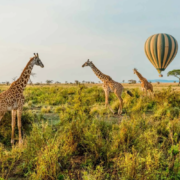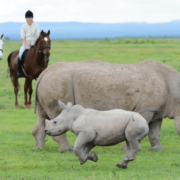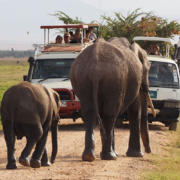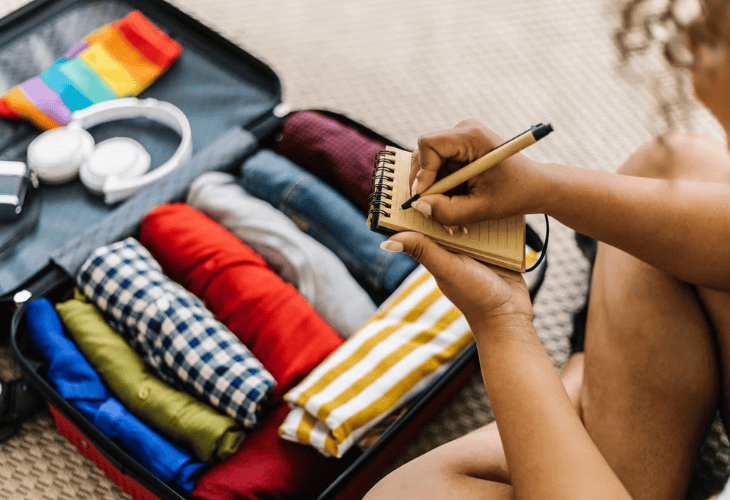
The Ultimate Safari Packing Guide for Kenya
Introduction
Do you need help with what to pack for an enjoyable Kenyan Safari? Fret not. This post is a go-to resource for suitable packing tips to implement as you explore the Kenyan wilderness in any season.
So, what should your suitcase feature? Well, it depends on the season and the type of activities that you will participate in. Different clothes serve different purposes. For instance, you may need specific attire when walking in the African bush.
Moreover, varying situations attract specific wear. If you are touring during the cold season, dress for the occasion. Suppose you explore Kenya in dry seasons; remember to consider dusty game drives while wearing safe gear to handle the prevailing conditions.
Then again, we will equip you with the correct details to enable you to pack efficiently for a Kenyan safari. For instance, you may need relevant gear to view wildlife, dress skillfully according to the prevailing weather, or adjust your attire as you explore various terrains in the country.
Daylight Adventures has your interest at heart. We want to make your work easier during your packing journey. We will offer valuable tips to ensure your suitcase has what it takes for a thrilling safari in Kenya. Let’s dive in.

A typical suitcase for packing safari essentials for use during a Kenyan safari experience
An Overview of Kenyan Safari
Hear this: you can only pack rightly if you understand what a Kenya safari looks like before aligning your suitcase to match the expectations. Here are some insights for you:
a) Varying Safari seasons
Kenya has two seasons: dry and wet. The dry season falls between June and October, and it is the right time to spot the Big Five and other animals since they gather around water sources for refreshment.
Furthermore, it is the right time to watch the spectacular Great Migration as wildebeests and zebras move from Maasai Mari to Serengeti National Park.
Again, the wet season offers a charming bird-watching experience featuring lush landscapes and dense vegetation.
During this period, you can watch the migratory species from Asia and Europe that flock to this region for survival. The local species include flamingoes of Nakuru, which provide breathtaking views for your photos and video recordings.
b) Diverse Ecosystems
Kenya has savanna plains characterized by chilly nights and scorching days. During this time, you should wear breathable clothes during the day and warm layers during evening drives.
Furthermore, the ecosystem features forests, which are natural habitats for birds and other primates. When visiting these forested areas, wear waterproof boots and moisture-wicking clothing.
Similarly, mountainous regions offer special hikes for an unforgettable Kenyan safari experience. Some spots could be the Aberdare ranges or Mount Kenya, where you must pack good hiking boots and warm layered clothing.
Better yet, lakes in different parts are the best habitats for fish, hippos, crocodiles, and birds. These lake regions feature hot and humid weather, demanding the visitor pack lightweight and quick-drying attires.
c)Typical Safari Activities
Several safari activities could include bush walks, games, or night drives. For bush walks, you can use the Daylight Adventures guides to learn finer details of certain plants and insects that are more visible at a closer range.
Also, one can participate in night drives in certain game parks to witness the charming behaviors of certain wildlife, such as owls, hyenas, or lions. During the day, you can participate in game drives to witness wildlife and experience different terrains in Africa’s wilderness.
Essential Clothing and Footwear
Kenya has a unique climate featuring chilly mornings, evenings, and hot middays, especially during seasons.
Opt for warm clothing in the morning and lightweight and breathable attire during midday to match the prevailing changes. The critical point is that visitors should always feel comfortable at any temperature. Here are a few tips that you can implement.
a) Safari-Appropriate Clothing
A thoughtful preparation is key when packing for a Kenyan Safari. Above all, consider comfortable and protective wear to match the conditions on the ground. Typically, a perfect safari wardrobe should include the following items:
We advise that you select the right material, which should be breathable and withstand the savannah’s heat.
- Cotton: It is the best material for your attire since it is breathable and comfortable. The only downside is that it does not dry quickly during cold seasons. However, the best part is that it does not retain odors.
- Synthetic blends: Consider a material that wicks away moisture and dries quickly when traveling. Nylon and polyester blends fit well in this category. The catch is that these materials have built-in UV protection and are wrinkle-resistant.
- Performance Fabrics: Appropriate outdoor attire should have excellent properties such as quick drying capabilities, UV protection, and moisture-wicking characteristics. Such attire is crucial for your adventure on a spectacular Kenyan safari.
What is the Recommended Safari Attire?
Consider wearing neutral colors such as beige, khaki, or olive, which blend well with the surroundings. Bright colors should be avoided since they attract insects and scare off wildlife.
Neutral colors are an asset, preventing insect bites and offering sunlight protection. Proper clothing is a must since you will pass through bushes; hence, you need skin protection against thorns in the bushes.
Kenya experiences intense sunlight, so you need protection from harmful sun rays. In response to this condition, select a well-brimmed hat featuring chin straps for a secure fit against wind.
Moreover, tourists should have sunglasses to enhance their visibility, especially when viewing the ecosystem in bright conditions. Lastly, they need a neck gaiter to shield their necks from the sun and dust.
b) Footwear for Safaris
Visitors require correct footwear to navigate the Kenyan terrain, comfort and safety notwithstanding. Here are factors to consider as you locate suitable footwear for your safari:
Lightweight, Comfortable Walking Shoes
While on a walking or game drive safari, you may experience varying landscape surfaces, such as rocky, uneven, or covered with thick vegetation. Look for a lightweight hiking shoe that makes your journey comfortable. The right shoes should have the best ankle support for comfort as you traverse different landscapes.

Lightweight and sturdy safari boots
Sturdy
Furthermore, the right shoe should have a thick, rugged sole shielding your feet from thorns and sharp rocks. Trail running shoes can be ideal for a general walk as they are comfortable, offer good balance, and are breathable.
Sandals
Heavy footwear is suitable for outdoor activities; however, you must pack sandals for your leisure time in your accommodation area. Sandals serve you best after spending a long day in boots, providing needed comfort when relaxing at lodges. Go for sturdy sports sandals, perfect for camps and lodges.
When buying proper sandals, look for breathability, comfort, durability, and neutral colors. Kenya is equally hot, so you need breathable footwear to eliminate sweat from your feet.
We recommend you pack two pairs of shoes to alternate and allow the next to dry well. Use thick, moisture-wicking socks for dry feet and blister prevention. Also, a shoe brush is a must to eliminate dust and dirt after every activity at the end of the day. Also, one should wear waterproof shoes during wet seasons.
c) Attires for Evening and Lodge Time
After a long journey filled with exciting activities and thrilling experiences, you may retreat to your camp of lodges for relaxation and refreshment. Proper attire is required during this time.
First, the temperatures always drop in the evening, so you may need to pack sweaters or jackets that offer warmth for an outdoor dining experience.
Furthermore, you need long pants for mosquito protection. You should also have a comfortable blouse or shirt in neutral colors and breathable fabrics. For outdoor dining areas, we recommend that you wear closed-toe shoes.
What should the dress code be for luxury lodges?
There is no specific standard to apply; however, some lodges encourage visitors to appear more refined for dinner. Look for smart casual attire.
For ladies, go for a skirt or a sundress. Wear neat and presentable shorts in the evenings. As for men, you can wear a blazer or a light jacket before going for dinner at high-end lodges.
Personal Items and Toiletries
a) Basic Personal Care Items
When planning for an exclusive Kenyan tour, ensure your wardrobe contains elements that protect you from harsh sunlight, as suggested in the following list:
1. Sunscreen
You need enough protection from intense sunlight, even on cloudy days, to avoid skin damage.
First, you need a high SPF to protect yourself from UVA and UVB rays. Furthermore, buy a water-resistant option to withstand sweat and water splashes.
If you visit coastal regions, ensure you carry marine-safe sunscreens to protect your eyes from marine ecosystems. Apply the sunscreen to your body at least thirty minutes before exposure to the sun.
Additionally, you can reapply every two hours after excessive sitting or swimming. If you have sensitive skin, use a face-specific sunscreen.
2. Insect Repellant
Kenya is a malaria-prone area, so protecting yourself against mosquitos that carry malaria is vital to staying comfortable and healthy. You can buy substances with a higher DEET concentrations for the best protection. Better yet, you can use natural remedies such as applying eucalyptus oil.
Apply this oil to your body and clothes. If you use sunscreen and insect repellant, apply the sunscreen and top it up with the repellent. For relent, the best time is in the evening or morning when these mosquitos are active.
3. Lip Balm with SPF
You need to protect your lips against sun damage. The best option is a substance with at least SPF 15 or higher. The balm should contain nourishing agents to tackle dry conditions. You should apply this balm throughout the day, especially before sun exposure.
b) Toiletries
Your hygiene should be a top priority as you plan your safari in Kenya. First, oral hygiene is non-negotiable, so toothpaste and a toothbrush are necessary. Use the travel versions to maximize every available space. Furthermore, you need a mouthwash to enhance your dental hygiene.
Secondly, pack your favorite soap that aligns with your body’s needs. It could be an antibacterial or moisturizing soap to suit your skin type. You can pack a conditioner or a shampoo for hair care. Daylight Adventures recommends using travel-size bottles.
Your body odor should not be a nuisance. Buy a deodorant with a long-lasting formula to serve you throughout the day. Also, have a shaving kit with a comb for grooming purposes. Pack a nail clipper for further nail grooming.
Lastly, your packages should include wet wipes or tissues for quick clean-ups. Adhering to these items makes your safari comfortable and presentable regardless of your destination in Kenya.
c) First Aid Kits
Ensure you have a first aid kit that helps you handle any emergency, whether along the trip or while in your lodges. If you experience strains, have an elastic bandage to prevent swelling. Furthermore, you may include medical tape to hold the bandage securely.
Your package should also include pain relievers to alleviate pain and inflammation. Anti-acid tablets should handle any stomach-related complications. Finally, you need disposable gloves for wound care. When treating injuries, wear a mask to enhance your hygiene.
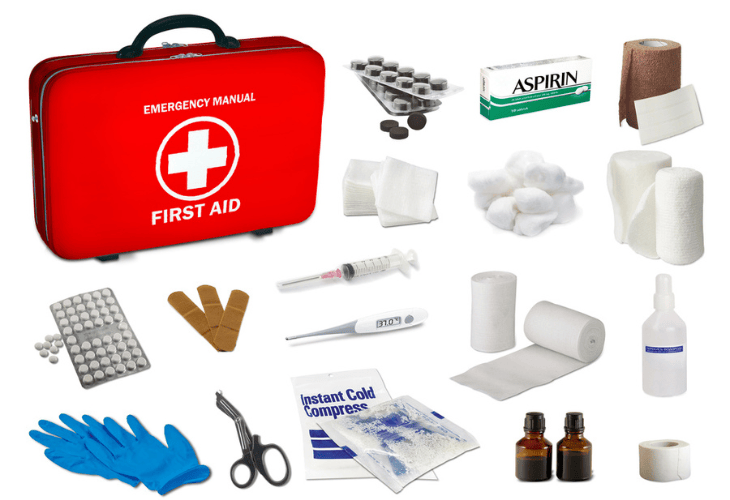
A typical first aid kit for use during any emergency on your trip
Safari Gear and Accessories
a) Binoculars and Cameras
A trip to Kenya is only memorable if you carry personal gear that will assist you in capturing scenic views and images for a lifetime encounter. The following list is hard to avoid:
1. Binoculars
Animals do not like disturbances; hence, you need a pair of binoculars to capture distant wildlife and draw them closer. Before getting suitable binoculars, look for the magnification. The standard size should be either 8x or 10x.
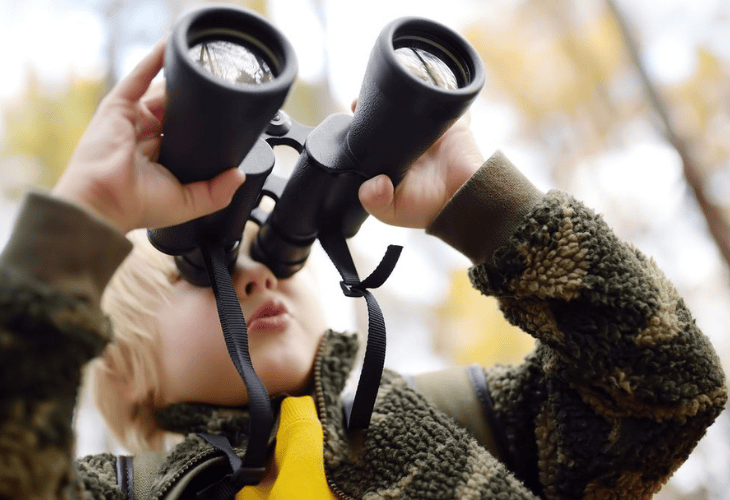
A young one using binoculars to view distant images of wildlife
Furthermore, these binoculars should have a wide view to effortlessly track moving animals. Durability is necessary when buying this essential item, as it should be water-resistant to withstand wet conditions.
Before using these binoculars, practice to become familiar with any technical aspects. Always use neck-straps to prevent them from falling. Lastly, ensure the lenses are always clean for better image clarity.
2. Cameras
As a traveler, you need a dedicated camera, which you may use to capture certain images with your smartphone camera.
Opt for a compact camera for easier portability. Alternatively, opt for a bridge camera, which is effortless to use and has unmatched zoom capabilities.
If you want the highest quality, consider a mirrorless camera with additional lenses. The only outstanding aspect of this option is that users need more skills before using it effectively.
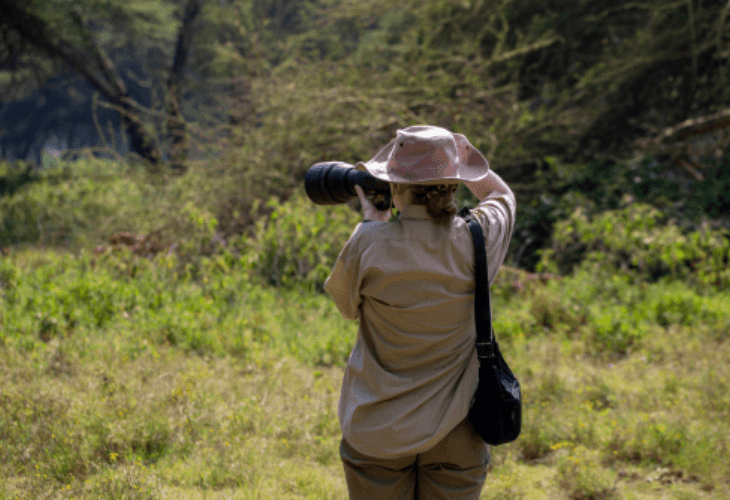
A tourist taking a photo
A camera should have a leather bag for protection against dust and bumps. Again, ensure you carry the lens cleaning kit to eliminate dust and get the best pictures. Carry extra batteries for power. Have memory cards for additional storage.
Before any trip, understand how your camera functions. Apart from wildlife, remember to capture camp life and landscapes, too.
b) Daypack Essentials
Daylight Adventures recommends a well-packed daypack as you go for your game drives. Avoid bulky packaging to allow easy movements as long as it has all the basic requirements to handle the day.
Your daypack should be made of durable, water-resistant, and long-lasting materials to protect its contents. The materials used should be neutral colors to complement the surroundings.
Additionally, it should be spacious, with a minimum 20-liter pack to hold the needed elements during the adventure. Finally, it should have a breathable back panel for increased comfort.
What are the basic contents of the daypack?
The first item is packaging at least two water bottles to keep your body hydrated throughout the trip. Furthermore, you should carry snacks for energy sustenance. Have all elements for sun protection, such as sunscreen SPF, sunglasses, and lip balm with SPF. Other essentials include:
- Camera gear
- Insect repellent
- Personal medications
- First aid kit
- Binoculars
- Wet wipes and sanitizers.
The best practice is to repack your daypack at the end of the day to better prepare for the following day. You can keep it light and organized for easier access.
c) Miscellaneous Safari Gear
As a traveler, you need a miscellaneous pack beyond your personal care essentials and clothing. Here is an exhaustive list to follows:
1. Lighting
The first thing to consider is the flashlight, as it is critical for use in low-light situations. The best model should have an option to adjust the brightness level. Purchase additional batteries for backup. We value headlamps, as they are convenient for hands-free operations.
2. Hydration
While navigating the African’s heat, you need mechanisms to keep your body cool and hydrated. Use reusable insulated water bottles to maintain cool temperatures. Opt for bottles with filters to enhance safety.

A tourist carrying a water bottle for hydration.
3. Power and Connectivity
Most safaris happen in remote regions, so you need gear to recharge your electronic devices. Look for a more flexible universal adapter. The models of your choice include more charging options to allow you to recharge many items at once.
Power banks are handy for charging items remotely. For efficiency, buy a 10,000mAh or higher model. Never forget to pack the charging cables, too.
Additionally, you should include dry bags to insulate your items from water. Furthermore, you can include a portable fan to cool the hot situations. A notebook can be essential for recording your safari experiences.
Health and Safety Considerations
1. Vaccinations and Health Precautions
Kenya is a tourist-friendly nation; however, you must understand all health protocols as you plan to tour and exploit its tourist resources for a thrilling experience. Here are some of the vaccines that you can never avoid to stay healthy:
a) Malaria
Kenya hosts mosquito insects, notorious for bites that spread malaria in your body. The antimalarial vaccine comes in handy to help you stay above such challenges. The most appropriate step is to liaise with your physician to properly prescribe antimalarial drugs.
Other measures include applying mosquito repellent to your skin and clothes to keep this insect away. Furthermore, you should sleep under a mosquito net to escape any mosquito bite that could escalate further.
b) Other Vaccines
Yellow fever vaccination is mandatory, especially for visitors from vulnerable countries. Depending on the duration of your stay, you should also get hepatitis A and B vaccines. A typhoid vaccine is a must, especially if you eat in restaurants that may expose you to contaminated water and food.
The best approach is to drink only bottled or boiled water and consume only thoroughly cooked food.
2. Insurance and Travel Documentation
When planning to exploit Kenyan terror, ensure you obtain insurance and travel documentation for a hassle-free experience.
Travel insurance is the initial document you cannot afford to miss on your trip. It is paramount as it intervenes when you lose your luggage or cancel your trip. Ensure that the insurance company handles critical aspects for a successful safari. Check if the policy takes care of pandemic diseases.
Besides, ensure you have all basic travel documents to prevent a last-minute rush. You must have a valid passport. Kenyan authorities require that every visitor obtain a visa, which you can apply for effortlessly online.
Moreover, you should have the itinerary and bookings. Keep copies of your flight tickets and accommodation bookings. Keep your vaccination records as proof that you meet all health protocols required by the Kenyan government.
Tech Gadgets for Safari
1. Smartphone
Technology is changing how we approach life; hence, a smartphone is the most critical device you cannot afford to miss on your packing list.
You can use a smartphone to capture scenic photos and make your safari more captivating. Furthermore, you can activate the GPS to track your safari routes.

A smartphone
Confirm with your guide for local SIM options and stay connected with home and local friends.
Smartphones can hold strategic apps to make your trip more fulfilling; Daylight Adventures recommends certain apps to make your tour easy and exciting, such as:
- iNaturalist: it is an effective app for wildlife identification. It has full details of all the fauna in East Africa.
- eBird: If you are a bird enthusiast, this app is a must-have, as it will help you locate birds and indicate perfect spots for identification.
- Maps.me: As you move around, you need to know every spot you navigate. This app has an offline map that helps you track your route effectively.
- Google Translate: Ensure you install this app, as you will need translation for the basic Swahili phrases as you interact with the local community.
- Sky Map: This app may be required to identify the constellations in the clear night sky.
2. Power and Charging
Recharging your device is critical to keep your devices alive, especially when touring remote destinations.
The good news is that Kenya enjoys long periods of sunlight during the day, thereby becoming an asset for applying solar charges to reenergize electronic devices such as cameras and smartphones.
The correct solar charger should feature multiple charging ports, enabling users to charge many items simultaneously. Furthermore, these chargers should have power banks to store energy for later use.
3. Communication Tools
As you tour remote areas, ensure you have vital tools to facilitate better communication as you keep in touch with your peers. First, you need a satellite phone during an emergency when another phone fails due to weak signals.
Furthermore, ensure you buy a local SIM card and activate it on your smartphone for better local coverage. However, you must have active accounts for certain apps like WhatsApp to stay updated with your guides and concerned people around you.
Lastly, you can opt for a two-way radio to facilitate more communication during drives. When visiting areas with limited internet connectivity, use a portable Wi-Fi hotspot.
Conclusion
Traveling in Kenya can be exciting if you stick to the packing tips suggested in this article. Your journey can be memorable if your suitcase contains all the basic elements that increase your comfort, health, and lifelong experience.
Observing health precautions is a step forward to prevent future hitches that could put you in a bad state. Thankfully, several vaccines exist, such as malarial medication and the yellow fever vaccine, to help your body resist any vulnerable conditions as you travel to your destination.
Daylight Adventures offers tips on ensuring your suitcase has the right gear to combat every situation you may encounter along your trip. For instance, you must dress according to the activity and the weather conditions.
Above all, you should carry gadgets that remind you of fond memories you will experience on your trip. A camera is a must-have for taking breathtaking pictures of all events that require your attention. Furthermore, you need binoculars to capture distant images of mammals to prevent disturbance.
Finally, your journey is now effective as you implement all the details captured in this post. Contact Daylight Adventures and Safaris for better deals for your bookings and reservations.


